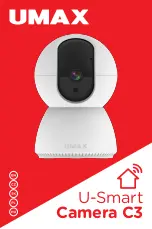
qCMOS Camera C15550-20UP Instruction manual_Ver.1.0
19
•
Place the camera the ventilation ports to be lateral side. Do not place the rear
panel of the camera, which connectors are located, to be at the bottom (Do
not block ventilation openings.).
•
When you connect cables, turn off the power supply of the camera and the peripheral devices.
Note
•
If you use the above options, see each installation manual.
AC adapter
This is the cord to supply a power supply. Use the accessory AC adapter.
Cooling water hose (at Water-cooling: Option)
It connects the camera and circulating water cooler. The insert position of WATER IN/OUT on the
camera WATER connector is not specified.
•
See 8 “WATER COOLING” for instruction of water-cooling.
CoaXPress interface cable 1 - 4 (Option)
These are the cables to connect the CoaXPress interface connector 1 to 4 of the camera and the
CoaXPress interface connector 1 to 4 on the computer, respectively.
•
When a connection interface is changed from CoaXPress to USB, and vice versa, the
application software must be closed and the camera must be turned off.
•
Do not connect CoaXPress and USB interface simultaneously.
Note
•
Hamamatsu recommends A14590-05-40 optional CoaXPress interface cable for this
camera. The camera complies with EMC and FCC regulations with using A14590-05-40
CoaXPress interface cable. Be careful that the camera with other interface cable may not
fulfill the EMC and FCC directive requirements.
USB interface cable (Option)
This is the cable to connect the USB interface connector of the camera and the USB interface connector
on the computer.
•
When a connection interface is changed from CoaXPress to USB, and vice versa, the
application software must be closed and the camera must be turned off.
•
Do not connect CoaXPress and USB interface simultaneously.
Note
•
Hamamatsu recommends A12467-03 optional USB interface cable for this camera. The
camera complies with EMC and FCC regulations
with using A12467-03 USB interface cable. Be careful that the camera
with other interface cable may not fulfill the EMC and FCC directive requirements.
















































